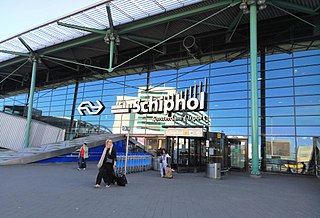
Nederlandse Spoorwegen is the principal passenger railway operator in the Netherlands. It is a Dutch state-owned company founded in 1938. The Dutch rail network is the busiest in the European Union, and the third busiest in the world after Switzerland and Japan.

The RijnGouweLijn, or RGL, was a proposed light rail project in South Holland, Netherlands, that used some new tracks and some existing tracks from the Gouda–Alphen aan den Rijn railway and the Woerden–Leiden railway. However, the new section might have used bus rapid transit (BRT) instead.
The following list focuses on the routes taken by trains traveling on railway lines in the Netherlands. A list including all stops on the train routes can be found at Dutch Railway Services.

Den Haag Centraal is the largest railway station in the city of The Hague in South Holland, Netherlands, and with twelve tracks, the largest terminal station in the Netherlands. The railway station opened in 1973, adjacent to its predecessor: Den Haag Staatsspoor, which was subsequently demolished. It is the western terminus of the Gouda–Den Haag railway.

Leiden Centraal is the main railway station in Leiden, a university city in the Netherlands. In 2019, it was the nation's sixth-most important station in terms of travel numbers, with 82.689 daily passengers. The station is an important transit hub for the c. 35,000 non-resident higher education students studying in the city, as well as for Leiden's surrounding area, including the seaside town of Katwijk.

Den Haag HS, an abbreviation of the original name Den Haag Hollands Spoor, is the oldest train station in The Hague, South Holland, Netherlands, located on the Amsterdam–Haarlem–Rotterdam railway. It is the second main station in The Hague and, unlike The Hague Central Station, it is not a terminus station. The name of the station is derived from the former Hollandsche IJzeren Spoorweg-Maatschappij (HIJSM) which was the first Dutch railway company.

Gouda is a railway station in Gouda, Netherlands. The station opened on 21 May 1855 when the Nederlandsche Rhijnspoorweg-Maatschappij opened the Utrecht–Rotterdam railway. The Gouda–Den Haag railway to The Hague was opened in 1870, and the connection to Alphen a/d Rijn in 1934.

Leiden Lammenschans is a railway station in Leiden, Netherlands. The station, designed by Koen van der Gaast, was opened on 18 May 1961. It is served by trains running between Leiden Centraal and Utrecht Centraal, and by RijnGouweLijn trains running between Leiden Centraal and Gouda at peak hours.

Nieuwerkerk aan den IJssel is a railway station in Nieuwerkerk aan den IJssel, Netherlands. The station is located on the Utrecht–Rotterdam railway between Gouda and Rotterdam Centraal. It was opened on 21 May 1971 and is mostly used by commuters. The train services are operated by Nederlandse Spoorwegen.

Woerden railway station is the railway station of Woerden, Netherlands. The railway station was opened on 21 May 1855 on the Utrecht–Rotterdam railway. In 1911 a new building was built in Jugendstil. During 1993-1996 the railway station was modernised, replacing the wooden roof and stairways by modern ones, while maintaining the Jugendstil building.

Utrecht Overvecht is a railway station located in Overvecht, Utrecht, Netherlands. The station opened in 1968 and is on the Utrecht–Kampen railway. The station has had 3 platforms since 1992. It also has a kids' slide from the outside street for use by busy passengers.

Rotterdam Centraal station is the main railway station of the city Rotterdam in South Holland, Netherlands. The station received an average of 112,000 passengers daily in 2019. The current station building, located at Station Square, was officially opened in March 2014.

Rotterdam Noord is a railway station in the city of Rotterdam in the Netherlands, located on the Utrecht–Rotterdam railway. It sits at the border between the two Rotterdam boroughs Noord and Hillegersberg-Schiebroek.

The Stadsgewestelijk Materieel or SGM was an electric multiple unit (EMU) train type that was operated by the Dutch railway company Nederlandse Spoorwegen. They were built from 1975 to 1983 by Talbot and retired from service between 2018 and 2021.

The Amsterdam–Schiphol railway is an important 17 kilometre long railway line in the Netherlands that connects Amsterdam with Amsterdam Airport Schiphol, and allows trains to continue to Leiden, The Hague, and Rotterdam.

The Amsterdam–Arnhem railway, also referred to as the Amsterdam–Elten railway or Rhijnspoorweg in Dutch, is an important railway that connects Amsterdam in the Netherlands with Utrecht and Arnhem, and continues into Germany.

Vleuten is a railway station located in Vleuten, Utrecht, Netherlands. The station was opened in 1881, and is located on the Utrecht–Rotterdam railway. The train services are operated by Nederlandse Spoorwegen.

On 21 April 2012 at 18:30 local time, two trains were involved in a head-on collision at Westerpark, near Sloterdijk, in the west of Amsterdam, Netherlands. Approximately 117 people were injured, one of whom later died in hospital. The collision is thought to have been caused by the driver of one of the trains passing a red signal.

Schiphol Airport station is a major passenger railway station in Haarlemmermeer, Netherlands, beneath the terminal complex of Amsterdam Airport Schiphol, operated by the Nederlandse Spoorwegen. The station's six platforms are accessible via twelve escalators and three elevators located in the main concourse of the airport. The original station was opened in 1978, and the current station in 1995. It connects the airport to Amsterdam and other cities in the Netherlands, as well as to Belgium and France.
































